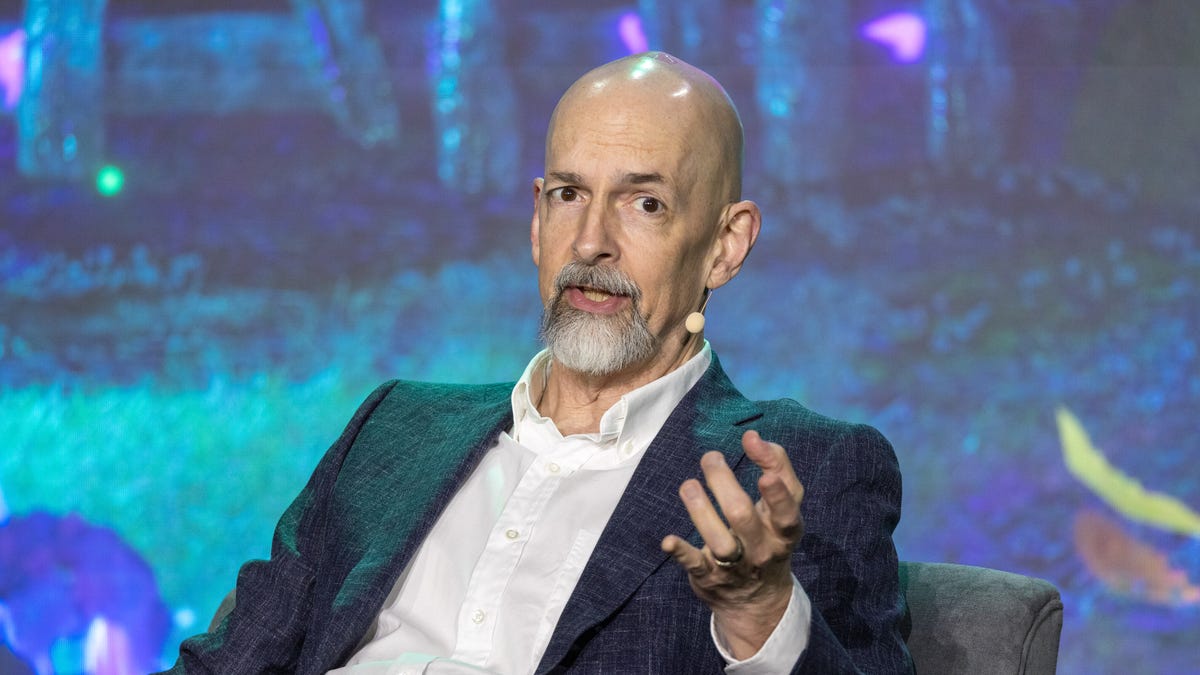The Man Who Named the Metaverse Is Optimistic Despite Waning Hype
Sci-fi author Neal Stephenson says the metaverse's foundations are maturing. New mixed reality headsets from Meta and Apple could help his case.

Neal Stephenson, author of the dystopian sci-fi novel Snow Crash that introduced the term metaverse, speaks at Augmented World Expo.
It's OK to be confused about the metaverse. Pessimists can point to Meta's difficulties over the last year convincing us we'll all inhabit this immersive 3D realm. Optimists can point to Meta's new $499 Quest 3 virtual and mixed reality headset, announced Thursday, and a competing headset Apple is expected to reveal in just a few days, as evidence that tech giants are still backing the idea of an immersive digital realm.
Put Neal Stephenson, whose 1992 dystopian sci-fi novel Snow Crash introduced the term metaverse, in the optimist camp.
"Just in the last couple of years, it feels like a bunch of things have snapped into place — the prerequisites that we need to have on hand in order to really start building a metaverse," Stephenson said Wednesday in a talk at Augmented Reality Expo.
Stephenson's vested interest just isn't from his novel. He's worked at several startups since the 1990s, including augmented reality headset maker Magic Leap, but his current effort, Lamina1, is working on metaverse plumbing it hopes will lead to an open foundation easy for developers to build upon and for people to visit.
It'll be a tough sell. The 2021 metaverse buzz has diminished greatly. Facebook renamed itself Meta, but investors have slammed its ambition to capitalize on the metaverse. And Web3 movement, which aimed to build "decentralized" metaverse tools that would reward those creating salable goods in the metaverse, has suffered persistent problems. That includes scams, security vulnerabilities and "rug pulls" in which project organizers hype a cryptocurrency then cash out, leaving investors with valueless assets.
Creative Strategies analyst Olivier Blanchard is a skeptic and the mainstream adoption of computer-generated virtual reality (VR), augmented reality (AR) that blends computer imagery with the real world, and the umbrella term encompassing both, mixed reality (XR).
"Once the AI gold rush cools off and Apple has finally given it some sense of direction, it is going to need to decide what it wants to be when it grows up if it has any hope of ever attracting mainstream consumers," Blanchard said. "Metaverse and XR companies are going to have to clearly communicate to users how their solutions will actually make their lives better rather than just more expensive and complicated."
But maybe the metaverse, or at least as tough a sell soon.
Apple's expected headset, years in the works and likely to emerge at the company's WWDC developer conference, could help convince developers to build mixed reality apps. Apple successfully wooed mobile developers to write millions of apps for iPhones and iPads. And Meta's Quest 3 XR headset has video pass-through mode will give it AR abilities.
The metaverse has a long way to go before matching the widespread adoption of today's web or the metaverse in Snow Crash.
Snow Crash is a rollicking novel that uses humor and adventure to take the edge off its dystopian vision. The metaverse plays a central role in the book, but Stephenson places the blame for the dystopia on human society more broadly. With the metaverse, Stephenson wanted to present a technology realm that accommodated a broad span of human activity.
"Our initial exposure to the metaverse is a kind of very vast market, a lowest common denominator to include ... the worst of television," Stephenson said. "But later on, as we get farther into the book, we see that people have used it to make beautiful works of art. There are some people ... who lavished a lot of time and attention on making homes in the metaverse that are exquisite works of art, both visually and in this sonic environment."
That metaverse was all about VR, but Stephenson takes a broader definition today, "a three dimensional virtual shared environment," which includes AR, too. Although Snow Crash is famous for its metaverse, there also are "gargoyle" characters in the book's real world, uber-techies hidden behind AR goggles who are constantly tapped into data feeds.
Stephenson said he was impressed with progress with VR, AR, and XR, in particular with game engine tools like Unity and Unreal Engine that are widely used for 3D graphics and gaming. But so far, there's not enough reason to hang out in the metaverse.
Ori Inbar, a leader of augmented, mixed, and extended reality technology, speaks at the AWE 2023 next to a virtual version of himself.
"If we're going to have a metaverse that's being used all the time by millions or billions of people, then there have to be experiences in the metaverse that are worth having," Stephenson said. Lamina1's goal is to improve the metaverse tooling so developers and other creators can build those experiences. That includes the blockchain and NFT technology that's lost much of its luster as cryptocurrencies lost much of their value since peaking in 2021.
Lamina1 is working on partnerships to flesh out the metaverse. One is with Mira, which is scanning the real world to create a virtual version, but several others are with game developers.
Stephenson helped to co-found Lumina1 in 2022, but he's pulled back some. He still serves as chairman, but in 2023, he resumed novel writing, too, he said.
At the Augmented World Expo, AR fans are abundant, including show organizer and AugmentedReality.org Chief Executive Ori Inbar, who shared the stage with a virtual, nearly life-size version of himself appearing in a telepresence box built by ARHT Media. Inbar spent much of his 20 minutes on stage at the show defending the technology, arguing that it's thriving despite the tech world's attention moving to AI.
"We won't rest until everyone uses XR, everywhere, all the time."

